Skulls Unlimited cleans over 50,000 skulls a year.
Learn More!

In bone business, skulls rate head and shoulders above skeletons
Oct 25, 2006
Robert K. Elder, Staff Reporter, Chicago Tribune
Gap-toothed grins surround Jay Villemarette, and he's selling them off for $395 to $795 a head.
Literally, a head. He sells skulls, among other skeletal specimens.
Bones have been Villemarette's business since 1986, when he founded the first incarnation of Oklahoma City's Skulls Unlimited International Inc.
"I bet we sell no more than 100 human skeletons a year," Villemarette says. "For skulls, that number is closer to 500 human skulls."
But where do they come from?
The Tribune first posed this question to Villemarette in July for a story about the purported skull of improv comedian Del Close. Prior to his death in 1999, Close had willed his skull to the Goodman Theatre for productions of "Hamlet" and other plays.
But the Tribune noticed anomalies in the skull donated to the Goodman by Charna Halpern, Close's creative partner and executor of his estate. That skull had 11 teeth (Close wore dentures) and the screws holding it together were rusty -- not congruent with a 7-year-old specimen.
Then, earlier this month, Halpern admitted the skull wasn't Close's. She tried to carry out his wishes but couldn't overcome the legal and medical logistics. So, Halpern says, she bought a medical specimen from Skokie's Anatomical Chart Co.
That company, now under new ownership, no longer sells real skeletons, nor do competitors Carolina Biological Supply Co. in Burlington, N.C., and Ward's Natural Sciences in Rochester, N.Y.
For a large part of the 20th Century, India had been the leading a source of human bones despite internal legal challenges and temporary bans, including a previous ban by the country in 1976. But the human bone market, fueled by medical and dental schools needing specimens, largely dried up in 1985, when India banned the practice.
"Years ago, we used to sell thousands of skulls for dental students," says Dan James, vice president of business development for Carolina Biological Supply Co.
A toothy human skull used to be among the back-to-school supplies for dental schools across that nation, he says.
"For years and years, everything came out of India. These were people . . . in places like Calcutta who just died on the streets. [The government] paid companies to pick up the bodies and dispose of them."
Since 1985, however, the few skeletons and skulls that do legally trickle through U.S. customs come from China, Villemarette says.
"They come from individual sources, not from companies. We've been told, informally, that they come from the Silk Road," he says, referring to Asia's 5,000-mile ancient trade route. "They are most likely merchants and travelers who died along the road."
Gunther von Hagens, German creator of the Body Worlds exhibit of preserved or "plastinate" human bodies, had long weathered speculation that his specimens were executed Chinese prisoners, a claim he disputes.
"I can absolutely guarantee that's not the case with our stock," Villemarette says. "The skulls we get are 20 to 200 years old. They arrive with dirt and roots on them."
In the U.S., only a handful of companies still sell human bones, including The Bone Room in Berkeley, Calif.
"I don't think I would express the same degree of sureness of where they come from," says owner Ron Cauble. "I hear stories and people tell me things but it's at the level of rumor. It's very difficult to track where these things come from, especially when you're getting anything out of China."
In business for 20 years, Cauble sells skulls for $250 to $750, though specimens without mandibles can cost $200.
His customers include doctors, educators and even police departments, which train "cadaver dogs" to find buried human remains. "I get those calls almost daily," he says.
"Frankly," he adds, "I sell more to artists than I do to doctors."
Though Skulls Unlimited deals primarily in animal skeletons for veterinarians and medical schools, Villemarette says they still sell a fair number of human bones.
The busy season for skulls isn't Halloween, he says. It's Christmas.
"It's the end of the fiscal year for teaching universities. Plus, for individuals, people are willing to spend more money on a high-end Christmas gift."

Leave a comment